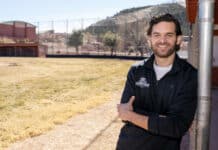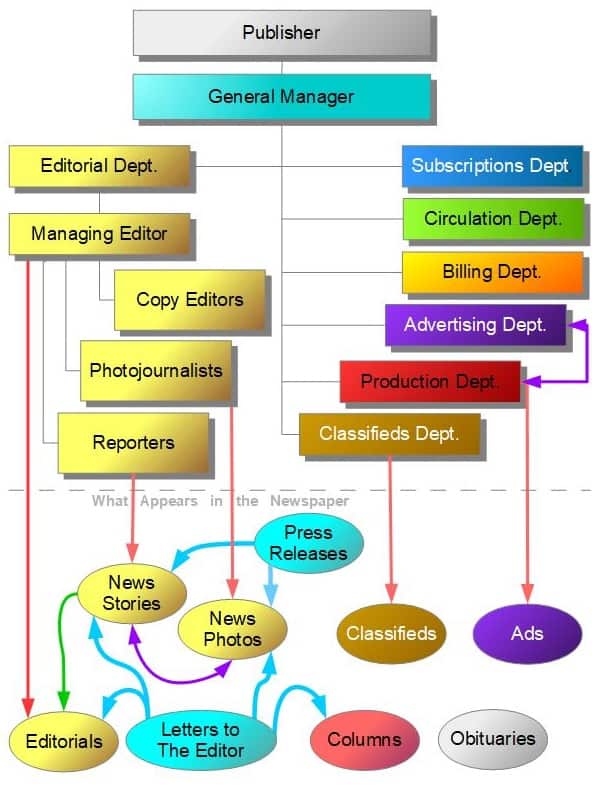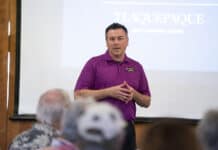Newspapers are not monolithic publications, like a textbook or novel, but are comprised of many component parts produced from various sources.
The basic architecture of a newspaper is determined by ads sold by advertising representatives in the Advertising Department. The number of ads, and which ones are paid to be printed in color, determine how many pages an edition of a newspaper will have and roughly where those pages are placed within the newspaper.
The rest of the open space on each page is filled by the Editorial Department, i.e., reporters, photojournalists, columnists and submissions from the public.
As a hyperlocal newspaper, the majority of our three newspapers — the Sedona Rock Rock News, The Camp Verde Journal and the Cottonwood Journal Extra, as well as the monthly The Village View in the Village of Oak Creek and The Scene arts section — are filled by press releases, submitted by members of our community. We occasionally run press releases from Yavapai or Coconino County, state of Arizona agencies or the federal government if there is local interest.
Press releases cover everything from meetings, arts events, community gatherings, classes, workshops, book releases, concerts and performances, police reports and law enforcement arrests, health warnings, traffic and construction notices and announcements of things like graduations, scholarships, new hires, awards, promotions, retirements, births, engagements, weddings and anniversaries. We also accept photos submitted by readers.
We have roughly 20 columns, some published weekly, others biweekly or monthly on a variety of topics. The columnists write on narrow topics related to their particular issue. Some, like Jeff Schalau’s Backyard Gardener column and Jacquie Randall’s Paw Prints, have been in our papers for more than 20 years.

The most important parts of our paper are the news stories written our journalists and photos taken by our photojournalists.
Photographs by our staff or the community are labeled underneath the photo with a photo credit, identifying who shot the photo. With a submitted photo, if the photographer is not known or the photographer doesn’t want credit, the credit states “Courtesy photo.”
Journalists attend events and meetings, investigate our local governments and go deep into issues of community interest. They just cover the facts and quote people involved related. The stories our journalists write are neutral and devoid of opinion or bias, although the people they quote may have opinions, sometimes strong ones. We do our best to quote both sides or the many sides of a news story so readers have a balanced view of the issue from these different perspectives.
While news coverage is neutral, some issues we cover require deeper analysis, so in every edition we publish an editorial commenting on the news, offering analysis or criticism or providing an opinionated stance on other issues of community interest. It’s easy to tell the difference between our editorials and our staff’s news stories. News stories are always published on our front page, but can also appear anywhere else in the newspaper.
Editorials are opinion pieces published only on Page 4A, under the headline “Editorial” on page labeled “Opinion,” so readers are aware these essays are not news stories, but opinionated commentaries on the news. When they appear on our website, they are categorized under “Opinion,” which appears at the top of the page, so there is absolutely no confusion for readers between our journalists’ unbiased news stories and our opinionated editorials, which take a clear stance on an issue.
Once we do take a stance on an ongoing topic, our journalists continue to write unbiased news stories regardless of what our editorial may have previously argued.
Also on Page 4A, we publish opinionated letters from you, our readers. If you want to comment on our news stories, criticize elected officials or government agencies, agree or disagree with our editorials or respond to other letters to the editor, Page 4A is where your opinion will appear.
While commenting quickly on social media may be cathartic, many social media users will never see them if they don’t click “view more comments.”
But on Page 4A, everyone who picks up our newspaper can see what you have to say. If you have any questions or want to submit a press release, photo or letter to the editor, email me at editor@larsonnewspapers.com.
— Christopher Fox Graham
Managing Editor





















